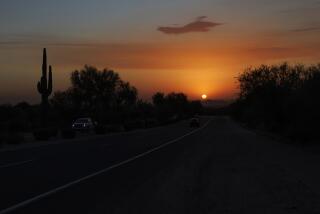To Sun-Scorched ‘Zonas,’ a S.D. Summer Is Phoenix by the Sea
How do Zonas get started?
Started by Phoenix people who
Drive and drive, they can’t survive,
Until they get to San Diego.
--from the satirical song “Zonas”
Arizona Gov. Bruce Babbitt likes to pay a visit to “Phoenix West” every summer. Terry Goddard, Phoenix’s mayor, has even campaigned for office there.
They are among the thousands of sun-scorched “Zonas” who kick the cactus spines off their boots and head for the ocean each August--and end up most frequently in San Diego.
“For most Phoenicians it is not a question of if they visit San Diego, but when they go,” said Melanie Johnston, spokeswoman for the Phoenix Convention & Visitors Bureau.
The most popular time for a pilgrimage to the Pacific is late summer, when Phoenix becomes a 115-degrees-in-the-shade ghost town.
About 6% of San Diego’s visitors--who totaled 29.3 million last year--are Arizona residents, according to the San Diego Convention & Visitors Bureau, but the percentage may swell considerably in the summer.
According to ConVis, 21% of all Phoenix residents vacation in San Diego. At one point last summer, four out of nine members of Phoenix’s City Council were in San Diego.
“We almost had a majority; one more person and we could have been in session,” said Bonnie Bartak, assistant to Phoenix Mayor Goddard.
Starting today, Goddard will be in San Diego to spend two weeks with the Navy Reserve, Bartak said.
At the beaches, outside hotels and on the freeways, the distinctive crimson, cactus-bearing tags are as common as sunshine in the desert.
While no one is certain when Phoenicians began to consider San Diego their summer annex, the summer flight has undoubtedly been fed by falling fuel prices and airline deregulation. The desert drive to San Diego takes about six hours, and the short plane hop runs as low as $43 each way.
But this summer, the migration has been marked by a furor rarely seen in the past, as local businesses have made more aggressive grabs for visitors’ dollars. In the last few weeks, several Phoenix radio stations have broadcast live shows from San Diego, and the parking lots at San Diego hotels and restaurants are jammed with Arizona license plates.
Two San Diego radio stations have spewed bitter satire across the airwaves in a backlash against the metropolitan mixing.
At the center of the storm is Randy Miller, the brash host of KSDO-FM’s morning show known for composing parodic jingles. A few weeks ago he began to notice the enormous influx of red-tagged, dust-covered cars packed full of Arizonans. In a flash of inspiration he came up with “Zonas.”
“Everywhere you go in San Diego you see these Arizona license plates on these cars that are stuffed with Zonas. My theory is that they breed on the way here,” Miller quipped. “The worst thing is that they travel in packs, with their ugly clothes and the metal detectors that they use to search for treasure at the beach.
“The song was really popular here, so I thought I would send it out to another radio station in Phoenix (KZZP-FM, 104.7) to see how people out there liked it.”
Reaction was overwhelming, and “Zonas” soon became the most-requested and most-reviled tune in KZZP’s library. The song even seemed to evoke a perverse sense of pride among the desert dwellers, and bumper stickers proclaiming “I’m a Zona” began to appear around the city.
Not to be outdone, a KZZP disk jockey named Rob (The Iceman) Isenberg fired back a riposte titled “Scum Diegos,” whose characterizations of San Diegans were anything but flattering.
The song declares:
Look at those Scum Diegos,
Bitchin’ about their luck.
Well those gnarly dudes
Would go down the tubes
Without our Zona buck.
In an attempt to mediate the powerful forces that the songs had unlocked, the two disc jockeys decided to visit each other’s cities. After spending most of Tuesday in Phoenix, Miller’s description of the city seemed as if it were scripted for a grade-B horror movie.
“It’s hard to say anything good about the city. It’s like the world’s largest bowling alley. It’s so hot that they never go outside; it’s so hot that the flesh melts from their bones,” he said.
Upon arriving at the KZZP station, Miller said, he was met by 100 heat-crazed Phoenicians, ready to rend him limb from limb.
“Fortunately I had 20 $1 bills, which I tossed in the air to distract them as I made my escape,” he said.
But the diplomatic exchange did generate what Miller refers to as his “peace initiative.” “I know that local businesses really depend on those Zonas, so my idea was that they would just send their money and keep their persons at home. I think it’s the only solution,” he said.
While Miller quixotically seeks to stem the flow of Zonas to San Diego, ConVis has spent $180,000 on a barrage of television, radio and newspaper advertisements designed to lure Arizonans to the city. The campaign, which paints San Diego as a cornucopia of culture, merchandise and water sports, has boosted travel from Phoenix to record levels, according to Sheila Fox, who oversees ConVis advertising.
Asked to respond to Miller’s composition, Dina Lazzarevich of ConVis said the song does not reflect the sentiments of most San Diegans toward their summer guests.
“We’re obviously not too happy about this,” she said. “Our job is to promote tourism, not to discourage it.”
ConVis is not the only San Diego organization seeking to boost the tourist trade. About 10% of Sea World’s 3.1 million visitors last year hailed from Arizona, and the aquatic amusement park has a permanent sales office in Phoenix. It even sends costumed salesmen to shopping malls there.
Phoenix radio stations have begun using satellite technology to bring their shows to where their listeners are--or at least where they wish they were.
KTAR (620 AM), a Phoenix talk-radio station, broadcast live from Sea World for two days last week. Talk show host Preston Westmoreland had local experts answer calls from Phoenicians who were curious about San Diego’s sights and restaurants.
“It was amazing how knowledgeable they were about the city,” said Anne Waldburger of ConVis, who appeared on the show. “They seemed to know more about our restaurants than most San Diegans.”
Another Phoenix radio station, KKLT (98.7 FM), took its listeners via satellite to Vacation Village Resort during the Fourth of July weekend.
“Since it was a long weekend and no one was going to hang around Phoenix, we wanted to give them the feeling that we were going away with them,” said program director Sam Church. He said that Phoenix in the summer is “as dead as Minneapolis in the winter.”
San Diego’s popularity to Phoenix residents is its proximity, a similar atmosphere and . . . the ocean.
“I think most people think of San Diego as Phoenix by the ocean,” said Daphne Dicino, a spokeswoman for Western Airlines. “When it gets over 100, all you can think about is getting to the water.”
Western recently increased the number of daily flights from Phoenix to San Diego from nine to 10, and every seat is booked, Dicino said.
At the Pacific Beach TraveLodge on Wednesday, 10 out of 20 cars had Arizona tags. Standing among a swarm of Zona offspring, Brent Craner said he was headed for the beach.
“San Diego’s a real nice city,” he said, “I particularly like the ocean and the Balboa Park area.”
Craner had driven through the desert in a brown Oldsmobile station wagon, stuffed with his four children. Of San Diegans, Craner remarked that he “never really had occasion to talk with ‘em.”
After all the brouhaha about “Zonas” and “Scum Diegos,” have any distinguishing marks of either breed been determined?
According to Miller, “Zonas” are alternately pale, fat, spendthrift, unhip tourists who can’t bear their hometown . . . or thin, leathery, reptilian, cheap, gawky, unhip tourists who can’t bear their hometown.
On the other hand, as any Phoenician will tell you, San Diegans are air-headed, obnoxious rattle-brains who parasitically subsist on the Arizona tourist dollar while living in a two-bit frontier village.
Commenting on the somewhat confused characterizations, Guy Zapoleon of KZZP said: “Let’s face it, neither city is all that cosmopolitan. Maybe the reason that this whole rivalry has developed is because Phoenix and San Diego are basically the same.”
More to Read
Sign up for The Wild
We’ll help you find the best places to hike, bike and run, as well as the perfect silent spots for meditation and yoga.
You may occasionally receive promotional content from the Los Angeles Times.






